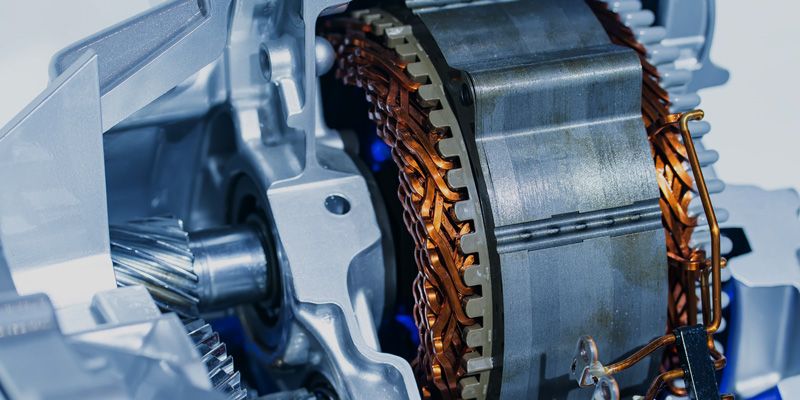
By Adam Thomas, Dir. NPI, Marketing & Founding Team
Electrification of the automotive industry continues as automakers around the world introduce new hybrid-electric- and electric-vehicles (HEV/EV). HEV/EV battery prices, previously 6-8% of an electric vehicle’s cost, have fallen roughly 87% in real terms since 2010 as manufacturing method improvements and economies of scale kick in. As increasing portions of the population and governments around the world attribute use of internal combustion engines to pollution and climate change, this cost reduction makes HEV/EVs more appealing to both consumers’ consciences and their wallets.
But what about the electromagnetic motors turned by the electrons stored in those HEV/EV batteries? The motors in HEV/EV drivetrains utilize high-performance electrical steel sheet laminations that are stacked into a motor core and wound with wire. The performance of the electrical steel can have substantial impacts on the power train system design, directly influencing the motor torque and vehicle range. The high-performance comes largely from the addition of silicon and aluminum to the steel, and additionally from extra gauge-reduction practices. HEV/EV market growth has driven the growth of the high-performance electrical steel market segment at double-digit annual rates for the last decade and is expected to continue to do so for the remainder of this decade. Consequently, this is driving investment by steel mills around the world to increase capacity or start new production of these grades. However, a deficit of this economically critical material is predicted in the second half of this decade as demand outpaces supply.
Coincidentally, the aerospace, medical, and other industries rely on even higher power density motors made from even higher grades of electrical steel than the grades used in the automotive industry. High power-density motors utilize high-performance grades of electrical steel laminations. Sometimes, these applications utilize Cobalt alloyed steels that are an order of magnitude more expensive than the highest grades of silicon and aluminum containing steels. Cobalt steels offer a very high power-density but are typically avoided in high-speed applications. When electric motors made from cobalt steels are operated at high-speed, and thus high-frequency, eddy currents and hysteresis generated in the motor core produce substantial heat waste. This heat can often necessitate cooling systems, thus cancelling out the benefit of the higher power-density offered by the cobalt steels. Increasingly, motor designers are looking to thinner and thinner grades of very high-performance electrical steels alloyed with silicon and aluminum to achieve high-power density at high speeds. Despite increased demand, achieving high-power density at high speeds in thin grades of high-performance electrical steels with desired alloy compositions remains a challenge for motor designers.
To meet current and future industrial demand for very high-quality electrical steels, Arcanum Alloys has developed a new class of electrical steel alloys made using a revolutionary steel manufacturing technology.
Arcanum Alloy’s SODA flat-rolled steel products are manufactured at full-scale on traditional coil processing assets. All of the metallurgically relevant alloying elements can be used in SODA products. Long-term, Arcanum Alloys endeavors to develop alloys the market wants (or can only imagine) and that existing mills cannot manufacture due to limitations on casting or rolling. In the short term, SODA enables Arcanum Alloys and its partners rapid entry into existing alloy markets using a fraction of the CAPEX typically required to enter a new market in the steel industry. Arcanum Alloys’ second product category, Opticore, is a range of non-grain oriented electrical steels designed for high-performance applications.
For mills looking to expand into electrical steels without making substantial CAPEX investments, SODA technology can be used to enrich the Silicon and Aluminum content of cold-rolled motor lamination steel or low-carbon steel. This can be achieved at virtually every gauge of starting material. For example, Arcanum offers light-gauge, Silicon and Aluminum alloyed Opticore grades at gauges from 0.010” (0.25-mm) to 0.004” (0.10-mm). These high-performance grades offer both excellent core loss and magnetic induction properties. As an example, Opticore 4 (at 0.004”, or 0.10-mm) offers core loss less than 10-W/kg at 1-Tesla and 400-Hz, while maintaining an induction greater than 1.71-T at a field strength of 5000-A/m. Another offering, Opticore 7 (at 0.007”, or 0.18-mm) has a core loss less than 11-W/kg at 1-Tesla and 400-Hz, while sporting a magnetic induction of 1.75-T at a field strength of 5000-A/m. In the graph below, these two grades of Opticore are compared over a range of frequencies at 1-Tesla of magnetic induction.

These properties are poised to meet the growing demand for motor and generator cores exhibiting high-efficiency and power density, without resorting to Nickel or Cobalt alloys. As more and more designers and applications demand that high-frequency motors fit into a compact form factors without cooling systems, Opticore is ready to meet the challenge.
For more information on Opticore or other SODA products, you can also see them at WMM 2020 in Rome, Italy from November 3rd to November 5th, and Magnetics 2021 from January 19 to January 20. Visit www.arcanumalloys.com



